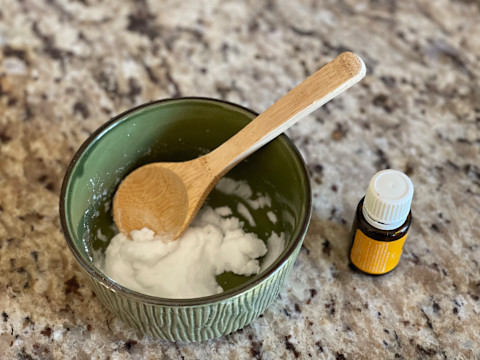How To Keep Your Stovetop Clean Using DIY Cleaners (You Only Need 3 Ingredients)

Every time you make pancakes in the morning, whip together lunch, or heat up a quick meal in the evening, your stovetop collects a little more grit and grime. And if not cleaned properly or regularly, it won't be the most hygienic place to make your meals every day. Here's the lowdown on how to keep your stovetop in tiptop shape using safe, homemade cleaners.
With stovetops, everyday maintenance is key.
Stovetop cleaning is often thought of as a tedious task, but it doesn't need to be! The trick is to stay on top of it by wiping down the area around your burners after every time you use the stove. This will prevent grit and grime from getting caked on over time and becoming super difficult to get off.
All you need to do so is a little white vinegar: Wait for your stovetop to cool, then spray a light layer of vinegar, as you would with an all-purpose cleaner, and wipe away. This does a good job of getting rid of grease and stains, and it can help keep your stovetop shiny too.
Once a week, I'd also recommend doing a more thorough stovetop clean. You can use your vinegar for that too, but you'll also want to add some baking soda to the mix using the following recipe.
If there are any caked-on stains, treat those using the following vinegar/baking-soda paste first, then spray with your cleaner.
A 3-Ingredient DIY Stovetop Cleaner
Ingredients:
- ¼ cup to 1 cup baking soda, depending on the size of your stovetop
- A spray bottle of white vinegar (If you don't have a spray bottle, you can just pop the nozzle from another product on your vinegar bottle—but be sure to wash and dry it first.)
- Dish soap
- A soft sponge or cloth
Method:
- If your stove has removable burners, bring those over to the sink (make sure they're cool first!) and scrub down with soap and warm water. If they have any stubborn stains, you can treat them using the paste below. Leave to air dry.
- Meanwhile, wipe the surface of your stovetop clean to get rid of any crumbs or charred remains.
- Sprinkle a thin layer of baking soda across your stovetop, avoiding the burners.
- Next, simply spray vinegar over the baking soda, and watch it react by fizzing. Wipe away with a soft sponge or cloth. If any baking soda residue stays behind, simply spray the area lightly with vinegar again and wipe away. Use a soft sponge or a soft cloth and scrub gently so you don't scratch the stovetop's surface. (In the case of a glass or induction stovetop, too much pressure may also crack it!)
A DIY Paste for Stubborn Stovetop Messes

Ingredients:
- 2 tablespoons baking soda
- 1 teaspoon water
- A spray bottle of white vinegar
- 3 to 5 drops lemon, orange, or another citrus essential oil (optional)
- A soft sponge or cloth
Method:
- In a small bowl, combine 2 tablespoons of baking soda and 1 teaspoon of water and mix together to make a paste. To provide a nice smell and some extra degreasing power, add a few drops of lemon, orange, or citrus essential oil (optional).
- Spread the paste over the grimy areas, and lightly spray vinegar over the paste to make it fizz. This makes it even easier to clean. Scrub gently; use a soft sponge, and don't scrub too hard so you don't scratch the surface.
- For stubborn areas, let the stain dry completely, and then spray lightly with vinegar before scrubbing your paste on top of it.
The benefits of a DIY stovetop cleaner.
Besides being a cheaper option that uses products you probably already have in your pantry, DIY stovetop cleaners don't contain the same potentially harmful chemicals that some common store-bought ones do, including sodium hypochlorite, the active ingredient in liquid bleach that's been linked to developmental and reproductive issues1, and glycol ethers, which have been linked to liver and kidney damage, fatigue, nausea, and anemia2.
And surprisingly, some cleaners we might typically use to clean glass or ceramic surfaces, such as ammonia-based glass cleaners, are too strong and may stain the cooktop surface or emit harmful fumes if not completely rinsed before heating.
The bottom line.
Cleaning your stovetop doesn't have to be complicated or time-consuming. The trick is wiping it down after every use and keeping some vinegar and baking soda on hand in your kitchen for those times more stubborn messes inevitably form.
